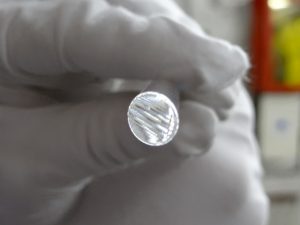 “Seeing” a high energy particle requires special detectors exploiting peculiar phenomena of interaction of particles with the matter. The Cherenkov effect is one of such phenomena: when a high energy particle crosses a material (a “radiator”) flashes of blue (or even ultra-violet) light are emitted. Such emission happens whenever the particle crosses the radiator with a speed larger than the light speed in that same material, an analog of the supersonic “boom” of the aircraft when they moves faster that the speed of sound.
“Seeing” a high energy particle requires special detectors exploiting peculiar phenomena of interaction of particles with the matter. The Cherenkov effect is one of such phenomena: when a high energy particle crosses a material (a “radiator”) flashes of blue (or even ultra-violet) light are emitted. Such emission happens whenever the particle crosses the radiator with a speed larger than the light speed in that same material, an analog of the supersonic “boom” of the aircraft when they moves faster that the speed of sound.
This effect is exploited by the researcher of the CRYSBEAM project of INFN (financed with an EU ERC Consolidator Grant) to develop and build particle detectors in which the radiator is made of synthetic quartz (namely fused silica). Fused silica has the important property to be transparent to the Cherenkov light. It can be inserted into a beam pipe of an accelerator and particles within the accelerator can be seen in this way.
A week long data taking dedicated to CRYSBEAM has just ended at the Beam Test Facility (BTF) in the Laboratori Nazionali di Frascati, in collaboration with researchers of the Laboratoire de l’Accélérateur Linéaire (Orsay, France). Successfully exploiting the 450 MeV electron beam, the joint team studied several types of radiators coupled to various light detectors, in the hope of finding the “best eye” for the best radiator, thanks to the remarkable stability of the BTF beam.
These data will aid the design and construction of a detector to be installed at the CERN accelerators (the Super Proton Synchrotron and the Large Hadron Collider – LHC) with the aim of observing particles extracted from the primary beam with a technique based on bent silicon crystals, developed in the context of the UA9 experiment at CERN.
 INFN-LNF Laboratori Nazionali di Frascati
INFN-LNF Laboratori Nazionali di Frascati